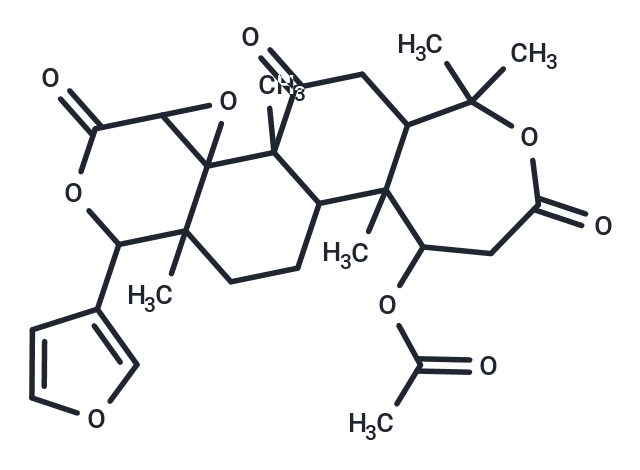Shopping Cart
- Remove All
 Your shopping cart is currently empty
Your shopping cart is currently empty

Nomilin is naturally occurring triterpenoids, have immunomodulatory activity.

| Pack Size | Price | Availability | Quantity |
|---|---|---|---|
| 5 mg | 37 € | In Stock | |
| 10 mg | 60 € | In Stock | |
| 25 mg | 122 € | In Stock | |
| 50 mg | 178 € | In Stock | |
| 100 mg | 268 € | In Stock | |
| 500 mg | 653 € | In Stock |
| Description | Nomilin is naturally occurring triterpenoids, have immunomodulatory activity. |
| In vitro | Administration of Nomilin significantly retarded endothelial cell proliferation, invasion, migration and tube formation. It also possesses anti-proliferative activity against the number of human cancer cell lines including leukemia (HL-60), ovary (SKOV-3), liver (Hep G2), cervix (HeLa), stomach (NCI-SNU-1), and breast (MCF-7)[2]. Nomilin significantly decreased TRAP-positive multinucleated cell numbers compared with the control and exhibited no cytotoxicity. It decreases bone resorption activity and downregulates osteoclast-specific genes, NFATc1 and TRAP mRNA levels. Furthermore, Nomilin suppressed MAPK signaling pathways. Thus, Nomilin has inhibitory effects on osteoclastic differentiation in vitro[3]. |
| In vivo | Nomilin is an effective inducer of gluthathione S-transferase activity in mice and to inhibit carcinogenesis in the hamster buccal pouch assay. Nomilin can shorten anaesthetic-induced sleeping time in mice, probably through a stimulant action on the central nervous system [1]. Nomilin significantly inhibited tumour-directed capillary formation. Serum proinflammatory cytokines such as IL-1β, IL-6, TNF-α and GM-CSF and also serum NO levels were significantly reduced by the treatment of nomilin. Administration of Nomilin significantly reduced the serum level of VEGF, a proangiogenic factor and increased the antiangiogenic factors TIMP-1 and IL-2 [2]. |
| Cell Research | Cell lines: HUVECs. Concentrations: 5 μg-500 μg/ml. Incubation Time: 48 h. Method:. HUVECs were seeded (5000 cells/well) in 96-well flat-bottomed titer plate and incubated for 24 h at 37 °C in 5% CO2 atmosphere. Different concentrations of Nomilin (5 μg-500 μg/ml) were added and incubated further for 48 h. Before 4 h completion of incubation, 20 μl MTT (5 mg/ml) was added. Percentage of dead cells was determined using an ELISA plate reader set to record absorbance at 570 nm. |
| Animal Research | Animal Models: Four to six week old male C57BL/6 mice. Formulation: light paraffin oil. Dosages: 6 mg/kg, I.P. |
| Molecular Weight | 514.56 |
| Formula | C28H34O9 |
| Cas No. | 1063-77-0 |
| Smiles | CC(=O)OC1CC(=O)OC(C)(C)C2CC(=O)C3(C)C(CCC4(C)C(OC(=O)C5OC345)c3ccoc3)C12C |
| Relative Density. | 1.33 g/cm3 |
| Storage | keep away from direct sunlight | Powder: -20°C for 3 years | In solvent: -80°C for 1 year | Shipping with blue ice. | ||||||||||||||||||||||||||||||
| Solubility Information | H2O: Insoluble Ethanol: Insoluble DMSO: 50 mg/mL (97.17 mM), Sonication is recommended. | ||||||||||||||||||||||||||||||
Solution Preparation Table | |||||||||||||||||||||||||||||||
DMSO
| |||||||||||||||||||||||||||||||

Copyright © 2015-2025 TargetMol Chemicals Inc. All Rights Reserved.